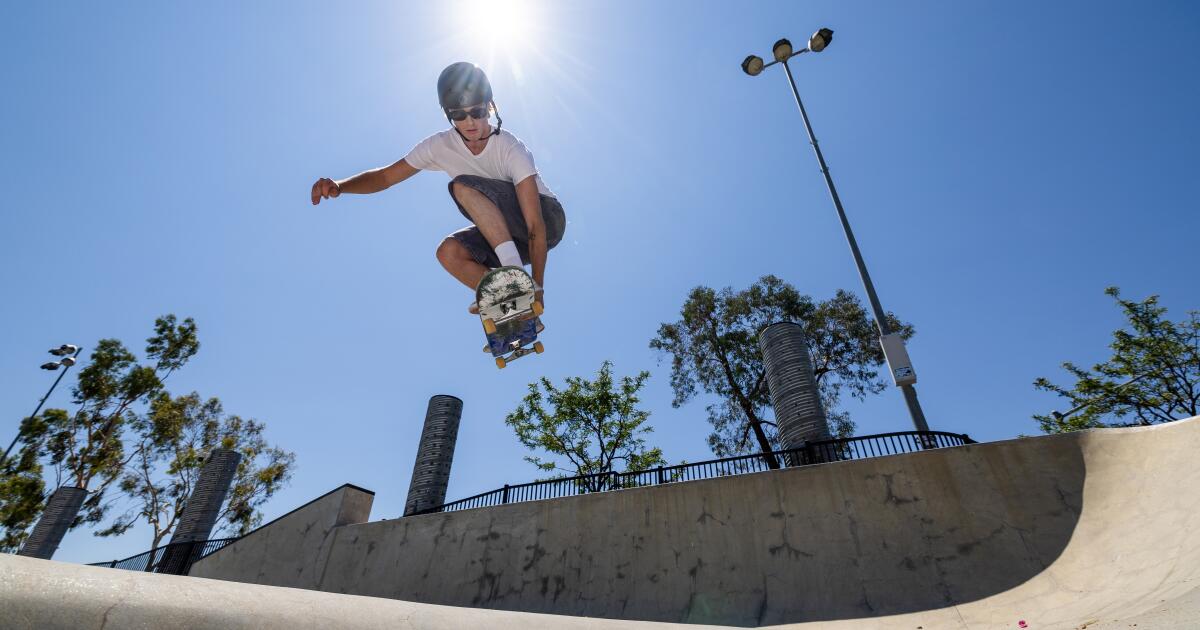Science
How do Olympic skateboarders catch serious airtime? Physicists crunched the numbers

Skateboarders call it “pumping,” and it’s a skill that both Olympic medalists and aspiring thrashers use to build launch speed from what seems like thin air.
But what separates the steeziest pro from the sketchiest beginner is the years’ worth of practice it takes to develop the know-how to execute the cleanest pump — or at least that was the case until now.
In a paper published Monday in the journal Physical Review Research, scientists have revealed the secret of achieving serious airtime.
A skateboarder rides the bowls at Etnies skatepark in Lake Forest. (Allen J. Schaben / Los Angeles Times)
With a bit of coding, researchers were able to describe the optimal technique for pumping — a tactic where skateboarders crouch down low momentarily and then push their body upright on inclines. To get the highest jump, they need to do it once as they descend into the bowl, and then again as they shoot back up toward the sky.
The trick is knowing when and where to execute the maneuver.
“Pumping is the foundation of skateboarding in skate parks,” said professional skater Haden McKenna, during a morning session at the Venice Beach Skatepark. “You build off of that and learn tricks. Then the pumping just becomes something in the back of your brain.”
However, the likeliest users of the researchers’ perfect pump equation are non-humans.
After skateboarding’s Olympic debut at the Tokyo Games, a research arm of the Japanese government reached out to Shigeru Shinomoto, a scientist at the Advanced Telecommunications Research Institute International in Japan. The organization had wondered if it was possible to build a skateboarding robot that could compete in the X Games.
The robot is still a ways off — right now it’s more like a toy that rides back and forth on a mini half-pipe — but the researchers discovered that the mechanics for good skateboarding technique can be surprisingly simple (well, at least compared to the complex fluid dynamics and neuroscience that they’re normally working on).
Kokona Hiraki of Japan crouches on her board before popping upright to pump at the Tokyo Olympics.
(Associated Press)
“It’s just this cute little project which became much bigger than we expected,” said Florian Kogelbauer, an author on the paper and a mechanical engineering professor at the public university ETH Zürich. “People like it — it’s a fun topic. It’s easy to explain, but some serious math and computational work went into it.”
To test their calculations, study authors recruited an expert skater with over a decade of experience, and a novice with just two years under their belt. They told the skaters to catch as much air as possible on a half-pipe erected in a research lab.
The result: The pro much more closely matched their calculated optimal motion than the amateur. (Ideally the skater would pop up instantaneously, but the researchers conceded that humans lack the unlimited muscle strength to do this — plus it would send the skater flying off their board.)
“The experiment seems to agree well,” said Frank Feng, a mechanical engineering professor at the University of Missouri who was not involved with the paper, but studied similar motions in half-pipe snowboarding.
Feng said the simple physics model gets researchers most of the way there, then the computer optimization is able to account for complexities that the physics equations can’t handle.
While the study was mostly just for fun, it snowballed into a fairly big project, and ended up getting published in one of the world’s premier physics journals. Part of the reason is that it may have some serious implications for how to get robots to move effectively without face-planting all the time.
It could help human skateboarders, too. Feng said the results could be used as a straightforward guide to help skateboarders train.
However, some question whether skaters would be able to use the information in the moment.
“This graph, showing the mass going up, is very helpful for somebody that can understand that,” said pro skater McKenna, who was not involved in the research. “But when you’re teaching kids and you’re trying to teach somebody that’s focused in the moment of skateboarding, they’re not going to be able to bring math into the equation.”
Also, out in the complex terrain of the park, the technique gets a bit more nuanced than a simple model the physicists developed. You need to flow as “one with the wall,” said McKenna. “Like what Bruce Lee says, ‘Be like water.’”

Skateboarder Greyson Godfrey, 20, of Rancho Santa Margarita drops into the bowl at Etnies Skate Park Lake Forest.
(Allen J. Schaben / Los Angeles Times)
While the researchers’ optimal solution may not always be the best suited for real-world conditions, it does help to illustrate the physics behind the technique.
Studio Gutierrez, who teaches skateboarding as a sports instructor to middle schoolers in the Los Angeles Unified School District, finds understanding the science helpful for new skaters. “I explain it to them in physics motions,” he said. “The more motion, the faster you go, the higher you get.”
The physics works similarly to how ice skaters increase the speed of their spinning in the Winter Olympics, said Kogelbauer. They start out spinning slow with their limbs extended outward. Then, they tuck their arms and legs in, causing them to spin faster.
Skateboarders also gain speed by using this technique on curved surfaces.
When a skateboarder hits the circular section of the half-pipe, they start crouched down, positioning their center of mass further from the center of rotation above their head. As they climb the curved ramp, they pop up and bring their center of mass closer to the center of rotation, and they speed up.
While the pumping paper is one of the first to capture the physics of pumping, its authors aren’t the only ones studying the motion of skateboarding.
Google has also taken a stab at a more complex understanding with its Project Skate. It’s using AI to identify different tricks and motions — but AI requires a lot of computing power that many researchers who aren’t Google don’t have access to.
“They have [essentially] unlimited resources. If they want to, they can take a new server farm and then run trajectories as much as they want.” said Kogelbauer. “That’s what Google does. We’re not Google.”
If you’d like to study pumping physics on your own, you can tune in to the Paris Olympics. The women skateboarders are scheduled to compete in the park event (as opposed to the street event, which has fewer curved surfaces for pumping) Tuesday morning. The men are scheduled for Wednesday.
McKenna has always seen skating more as an art form and community than a sport, but he’s stoked to watch nonetheless. “When I was a kid, which doesn’t seem that long ago, skateboarding was a crime, literally,” he said. “Now we’re winning gold medals in the Olympics.”

Science
At Chile’s Vera Rubin Observatory, Earth’s Largest Camera Surveys the Sky

At the heart of the new Vera C. Rubin Observatory in Chile is the world’s largest digital camera. About the size of a small car, it will create an unparalleled map of the night sky.
The observatory’s first public images of the sky are expected to be released on June 23. Here’s how its camera works.
When Times reporters visited the observatory on top of an 8,800-foot-high mountain in May, the telescope was undergoing calibration to measure minute differences in the sensitivity of the camera’s pixels. The camera is expected to have a life of more than 10 years.
A single Rubin image contains roughly as much data as all the words that The New York Times has published since 1851. The observatory will produce about 20 terabytes of data every night, which will be transferred and processed at facilities in California, France and Britain.
Specialized software will compare each new image with a template assembled from previous data, revealing changes in brightness or position in the sky. The observatory is expected to detect up to 10 million changes every night.
Some changes will be artificial. Simulations suggest that roughly one in 10 Rubin images will contain at least one bright streak or glint from the thousands of SpaceX Starlink and other satellites orbiting Earth.
Despite streaks, clouds, maintenance and other interruptions over the next decade, the Rubin Observatory is expected to catalog 20 billion galaxies and 17 billion stars across the Southern sky.
Science
'We are still here, yet invisible.' Study finds that U.S. government has overestimated Native American life expectancy

Official U.S. records dramatically underestimate mortality and life expectancy disparities for Native Americans, according to a new, groundbreaking study published in the Journal of the American Medical Association. The research, led by the Boston University School of Public Health, provides compelling evidence of a profound discrepancy between actual and officially reported statistics on the health outcomes of American Indian and Alaska Native (AI/AN) populations in the U.S.
The study, novel in its approach, tracks mortality outcomes over time among self-identified AI/AN individuals in a nationally representative cohort known as the Mortality Disparities in American Communities. The researchers linked data from the U.S. Census Bureau’s 2008 American Community Survey with official death certificates from the Centers for Disease Control and Prevention’s National Vital Statistics System from 2008 through 2019, and found that the life expectancy of AI/AN populations was 6.5 years lower than the national average. They then compared this to data from the CDC’s WONDER database, and found that their numbers were nearly three times greater than the gap reported by the CDC.
Indeed, the study found that the life expectancy for AI/AN individuals was just 72.7 years, comparable to that of developing countries.
The researchers also uncovered widespread racial misclassification. The study reports that some 41% of AI/AN deaths were incorrectly classified in the CDC WONDER database, predominantly misrecorded as “White.” These systemic misclassifications drastically skewed official statistics, presenting AI/AN mortality rates as only 5% higher than the national average. When they adjusted the data to account for those misclassifications, the researchers found that the actual rate was 42% higher than initially reported.
The issue of racial misclassification “is not new for us at all,” said Nanette Star, director of policy and planning at the California Consortium for Urban Indian Health. The recent tendency for journalists and politicians to use umbrella terms like “Indigenous” rather than the more precise “American Indian and Alaska Native” can obscure the unique needs, histories and political identities of AI/AN communities, Star noted, and contribute to their erasure in both data and public discourse. “That is the word we use — erasure — and it really does result in that invisibility in our health statistics,” she said.
Issues related to racial misclassification in public records persist across the entire life course for AI/AN individuals, from birth to early childhood interventions to chronic disease and death. Star noted that in California, especially in urban regions like Los Angeles, Native individuals are frequently misidentified as Latino or multiracial, which profoundly distorts public health data and masks the extent of health disparities. “It really does mask the true scale of premature mortality and health disparities among our communities,” Star said.
Further, said Star, the lack of accurate data exacerbates health disparities. “It really is a public health and justice issue,” she said. “If you don’t have those numbers to support the targeted response, you don’t get the funding for these interventions or even preventative measures.”
According to U.S. Census data, California is home to the largest AI/AN population in the United States. That means it has a unique opportunity to lead the nation in addressing these systemic issues. With numerous federally and state-recognized tribes, as well as substantial urban AI/AN populations, California can prioritize collaborative and accurate public health data collection and reporting.
Star noted that current distortions are not always malicious but often stem from a lack of training. She suggested that California implement targeted training programs for those charged with recording this data, including funeral directors, coroners, medical doctors and law enforcement agents; allocate dedicated resources to improve the accuracy of racial classification on vital records; and strengthen partnerships with tribal leaders.
The study authors suggest similar approaches, and there are numerous examples of successful cases of Indigenous-led health partnerships seen across Canada and the U.S. that have helped reduce health disparities among AI/AN communities that could be used as a template.
These efforts would not only help to move toward rectifying historical inaccuracies, but also ensure that AI/AN communities receive equitable health resources and policy attention.
“When AI/AN people are misclassified in life and in death, it distorts public health data and drives inequities even deeper,” said Star. “Accurate data isn’t just about numbers — it’s about honoring lives, holding systems accountable and making sure our communities are seen and served.”
Science
Supreme Court upholds red-state laws that ban hormones for transgender teens

WASHINGTON — The Supreme Court ruled Wednesday that states may ban hormone treatments for transgender teens, rejecting the claim that such gender-based discrimination is unconstitutional.
In a 6-3 decision, the justices said states are generally free to decide on proper standards of medical care, particularly when health experts are divided.
Chief Justice John G. Roberts, writing for the court, said the state decides on medical regulations. “We leave questions regarding its policy to the people, their elected representatives, and the democratic process,” he said.
In dissent, Justice Sonia Sotomayor said the law “plainly discriminates on the basis of sex… By retreating from meaningful judicial review exactly where it matters most, the Court abandons transgender children and their families to political whims. In sadness, I dissent.” Justices Elena Kagan and Ketanji Brown Jackson agreed.
The ruling upholds laws in Tennessee and 23 other Republican-led states, all of them adopted in the past four years.
Tennessee lawmakers said the number of minors being diagnosed with gender dysphoria had “exploded” in recent years, leading to a “surge in unproven and risky medical interventions for these underage patients.”
California and other Democratic-led states do not prohibit doctors from prescribing puberty blockers or hormones for those under age 18 who are diagnosed with gender dysphoria.
While the court’s ruling in the Tennessee case should not directly affect California’s law, the Trump administration seeks to prevent the use of federal funds to pay for gender affirming care.
This could affect patients who rely on Medicaid and also restrict hospitals and other medical clinics from providing hormones and other medical treatments for minors.
Wednesday’s decision highlights the sharp turn in the past year on trans rights and “gender affirming” care.
Solicitor Gen. Elizabeth Prelogar, representing the Biden administration, had appealed to the Supreme Court in November 2023, and urged the justices to strike down the red-state laws.
She spoke of a broad consensus in favor of gender affirming care. It was unconstitutional, she argued, for states to ban “evidence-based treatments supported by the overwhelming consensus of the medical community.”
But Republican lawmakers voiced doubt about the long-term effect of these hormone treatments for adolescents.
Their skepticism was reinforced by the Cass Report from Britain, which concluded there were not long-term studies or reliable evidence in support of the treatments.
Trans-rights advocates argued the court should have deferred to parents and their doctors, not state lawmakers.
“The court today failed to do its job,” said Jennifer Levi, GLAD Law senior director of transgender and queer rights. “When the political system breaks down and legislatures bow to popular hostility, the judiciary must be the Constitution’s backbone. Instead, it chose to look away, abandoning both vulnerable children and the parents who love them.”
Lawyers for Lambda Legal and the ACLU called it “a heartbreaking ruling, making it more difficult for transgender youth to escape the danger and trauma of being denied their ability to live and thrive.”
“This is a sad day, and the implications will reverberate for years and across the country, but it does not shake our resolve to continue fighting,” said Sasha Buchert, a Lambda attorney.
Upon taking office in January, President Trump targeted transgender people without specifically mentioning them.
He said his administration would “recognize two sexes, male and female. These sexes are not changeable and are grounded in fundamental and incontrovertible reality.”
His administration later said its ban on gender affirming care for minors would extend to medical facilities receiving federal funds.
-

 Business1 week ago
Business1 week agoYale’s Endowment Selling Private Equity Stakes as Trump Targets Ivies
-

 Culture1 week ago
Culture1 week agoBarbara Holdridge, Whose Record Label Foretold Audiobooks, Dies at 95
-

 Culture1 week ago
Culture1 week agoA Murdered Journalist’s Unfinished Book About the Amazon Gets Completed and Published
-

 News1 week ago
News1 week agoYosemite Bans Large Flags From El Capitan, Criminalizing Protests
-

 Education1 week ago
Education1 week agoWhat Happens to Harvard if Trump Successfully Bars Its International Students?
-

 News1 week ago
News1 week agoTrumps to Attend ‘Les Misérables’ at Kennedy Center
-

 Arizona2 days ago
Arizona2 days agoSuspect in Arizona Rangers' death killed by Missouri troopers
-

 World1 week ago
World1 week agoSudan’s paramilitary RSF say they seized key zone bordering Egypt, Libya















